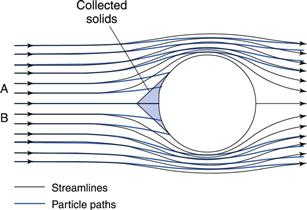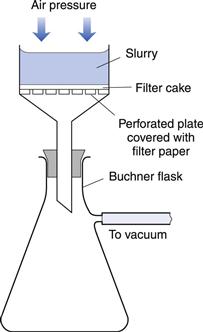Clarification
Andrew M. Twitchell
Chapter contents
Key points
• Clarification can be achieved using either filtration or centrifugation techniques.
• Straining/sieving and impingement are the main mechanisms by which filtration occurs.
Introduction
Clarification is a term used to describe processes that involve the removal or separation of a solid from a fluid, or a fluid from another fluid. The term ‘fluid’ encompasses both liquids and gases. Clarification can be achieved using either filtration or centrifugation techniques, both of which are described in this chapter.
In pharmaceutical processing there are two main reasons for such processes:
Filtration
Types of filtration
Solid/fluid filtration
Solid/fluid filtration can be defined as the separation of an insoluble solid from a fluid by means of a porous medium that retains the solid but allows the fluid to pass. It is the most common type of filtration encountered during the manufacture of pharmaceutical products. Solid/fluid filtration may be further subdivided into two types, namely solid/liquid filtration and solid/gas filtration.
Solid/liquid filtration.
There are numerous applications of solid/liquid filtration in pharmaceutical processing, some of which are listed below:
Solid/gas filtration.
There are two main applications of solid/gas filtration in pharmaceutical processing. One of particular importance in manufacturing is the removal of suspended solid material from air in order to supply air of the required standard for either processing equipment or manufacturing areas. This includes the provision of air for equipment such as fluidized-bed processors (see Chapters 28 and 29), film-coating machinery (Chapter 32) and bottle-cleaning equipment, so that product appearance and quality are maintained. The use of suitable filters also enables the particulate contamination of air in manufacturing areas to be at an appropriate level for the product being manufactured; for example, air free from microorganisms can be supplied to areas where sterile products are being manufactured.
It is also often necessary to remove particulate matter generated during a manufacturing operation from the process air in order to prevent the material being vented to the atmosphere. Examples of this include filtering of exhaust air from fluidized-bed and coating processes.
Fluid/fluid filtration
Flavouring oils are sometimes added to liquid preparations in the form of a spirit, i.e. dissolved in alcohol. When these spirits are added to aqueous-based formulations some of the oil may come out of solution, giving the product a degree of turbidity. Removal of the oil droplets by passing them through an appropriate filter (a liquid/liquid filtration process) is used to produce the desired product appearance.
Compressed air is used in a number of pharmaceutical processes, e.g. film-coating spray guns (Chapter 32), bottle-cleaning equipment and fluid energy mills (Chapter 10). Before use, the compressed air needs to be filtered to ensure that any entrained oil or water droplets are removed. This is an example of a fluid/gas filtration process.
Mechanisms of filtration
The mechanisms by which material may be retained by a filter medium (i.e. the surface on or in which material is deposited) are discussed below.
Straining/sieving
If the pores in the filter medium through which the fluid is flowing are smaller than the material that is required to be removed, the material will be retained. Filtration occurs on the surface of the filter in this case, and therefore the filter can be very thin (typically around 100 µm). Filter media of this type are referred to as membrane filters. Because filtration occurs on the surface there is a tendency for them to become blocked unless the filter is carefully designed (see later). Filters employing the straining mechanism are used where the contaminant level is low or small volumes need to be filtered. Examples of the use of membrane filters include the removal of bacteria and fibres from parenteral preparations.
Impingement
As a flowing fluid approaches and passes an object, for example a filter fibre, the fluid flow pattern is disturbed, as shown in Figure 25.1. Suspended solids may, however, have sufficient momentum so that they do not follow the fluid path but impinge on the filter fibre and are retained, owing to attractive forces between the particle and the fibre. Where the pores between filter fibres are larger than the material being removed, some particles may follow the fluid streamlines and miss the fibre, this being more likely if the particles are small (owing to their lower momentum) and as the distance from the centre of the fibre towards which they approach increases. To ensure the removal of all unwanted material, filter media using the impingement mechanism must be sufficiently thick so that material not trapped by the first fibre in its path is removed by a subsequent one. These types of filter are therefore referred to as depth filters. The fluid should flow through the filter medium in a streamlined manner to ensure the filter works effectively, as turbulent flow may carry the particles past the fibres. Depth filters are the main type of filter used for removing material from gases.
Attractive forces
Electrostatic and other surface forces may exert sufficient hold on the particles to attract and retain them on the filter medium (as occurs during the impingement mechanism).
Air can be freed from dust particles in an electrostatic precipitator by passing the air between highly charged surfaces, which attract the dust particles.
Autofiltration
Autofiltration is the term used to describe the situation when filtered material (termed the filter cake) acts as its own filter medium. This mechanism is used by the metafilter which is covered later in this chapter.
Factors affecting the rate of filtration
The filtration process chosen must remove the required ‘contaminants’ or product but must also do so at an acceptably fast rate to ensure that the manufacturing process can be carried out economically. The laboratory Buchner funnel and flask (Fig. 25.2) is a convenient filter that can be used to illustrate the factors that influence the rate at which a product can be filtered. This filter is used for solid/liquid filtration processes but the same basic principles are valid whatever filtration process is being evaluated.
The rate of filtration (volume of filtered material (V, m3) obtained in unit time (t, s) ) depends on the following factors:
• the viscosity of the fluid passing through the filter, i.e. the filtrate (µ, Pa s). A viscous fluid will filter more slowly than a mobile one owing to the greater resistance to movement offered by more viscous fluids (see Chapter 6)
Darcy’s equation
The above factors are combined in the Darcy equation:
 (25.1)
(25.1)
In this equation the driving force for this particular ‘rate process’ is the pressure difference across the filter, and the resistance to the process is a function of the properties of the filter bed, its thickness and the viscosity of the filtrate. The contribution to resistance to filtration from the filter medium is usually small compared to that of the filter cake, and can often be neglected in calculations.
Stay updated, free articles. Join our Telegram channel

Full access? Get Clinical Tree




